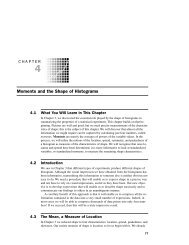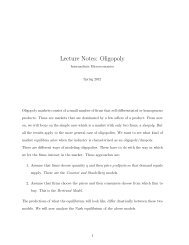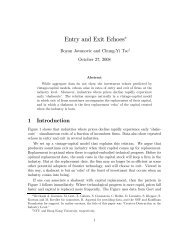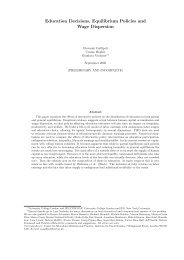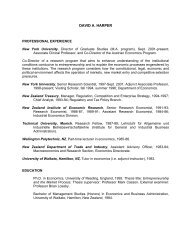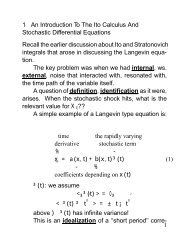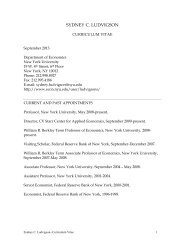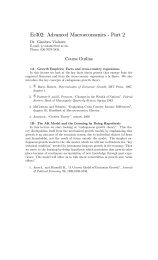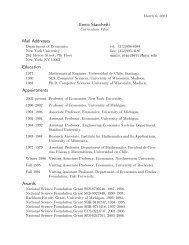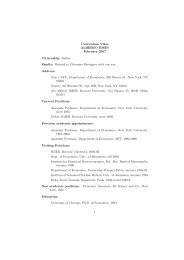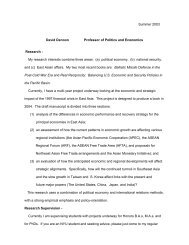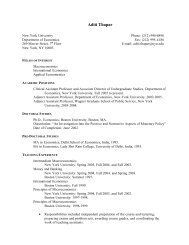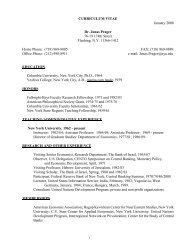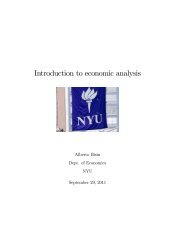On Spatial Processes and Asymptotic Inference under Near$Epoch ...
On Spatial Processes and Asymptotic Inference under Near$Epoch ...
On Spatial Processes and Asymptotic Inference under Near$Epoch ...
Create successful ePaper yourself
Turn your PDF publications into a flip-book with our unique Google optimized e-Paper software.
(b) infn jDnj 1 2 n > 0, where fDng is a sequence of …nite subsets of D such<br />
that jDnj ! 1 as n ! 1:<br />
(c) NED coe¢ cients satisfy P 1<br />
r=1 rd 1 (r) < 1:<br />
We can now state the following CLT for L2-NED r<strong>and</strong>om …elds.<br />
Theorem 1 Suppose fDng is a sequence of …nite subsets such that jDnj ! 1<br />
as n ! 1 <strong>and</strong> fTng is a sequence of subsets such that Dn Tn D of the<br />
lattice D satisfying Assumption 1: Let Y = fYi;n; i 2 Dn; n 1g be a real valued<br />
zero-mean r<strong>and</strong>om …eld that is L2-NED on a vector-valued -mixing r<strong>and</strong>om<br />
…eld " = f"i;n; i 2 Tn; n 1g. Suppose Assumptions 2 <strong>and</strong> 3 hold, then<br />
1<br />
n Sn =) N(0; 1):<br />
The above CLT contains the CLT for -mixing r<strong>and</strong>om …elds given in Jenish<br />
<strong>and</strong> Prucha (2009) as a special case. As shown earlier, the class of NED r<strong>and</strong>om<br />
…elds is an important extension of the class of -mixing r<strong>and</strong>om …elds, in that the<br />
class includes important <strong>and</strong> widely considered …elds, e.g., spatial autoregressive<br />
processes, that do not generally satisfy mixing conditions. It is for that reason<br />
that an estimation theory limited to the class of -mixing r<strong>and</strong>om …elds is not<br />
fully satisfactory; see, e.g., Gallant <strong>and</strong> White (1988) <strong>and</strong> Pötscher <strong>and</strong> Prucha<br />
(1997) for an analogous discussion in the time series literature. We note that<br />
Theorem 1 also contains as a special case the CLT for time series NED processes<br />
of Wooldridge (1986), see Theorem 3.13 <strong>and</strong> Corollary 4.4.<br />
Assumption 2 restricts the dependence structure of the input process ":<br />
Assumptions 3(a),(b) are st<strong>and</strong>ard in the limit theory of mixing processes,<br />
e.g., Wooldridge (1986), Davidson (1992), <strong>and</strong> de Jong (1997), <strong>and</strong> Jenish <strong>and</strong><br />
Prucha (2009).<br />
Assumption 3(a) is satis…ed if the Yi;n are uniformly Lp-bounded for some<br />
p > 2 + , i.e., sup n sup i2Dn kYi;nk p < 1. Assumption 3(b) is an asymptotic<br />
negligibility condition that ensures that no single summ<strong>and</strong> in‡uences disproportionately<br />
the entire sum. Assumption 3(c) controls the size of the NED<br />
coe¢ cients which measure the error in the approximation of Yi;n by ". Intuitively,<br />
the approximation errors have to decline su¢ ciently fast with each<br />
successive approximation. Assumption 3(c) is satis…ed if (r) = O(r d ) for<br />
some > 0; i.e., (r) is of size d.<br />
Theorem 1 can be easily extended to vector-valued …elds using the st<strong>and</strong>ard<br />
Cramér-Wold device.<br />
Corollary 1 Suppose fDng is a sequence of …nite subsets such that jDnj ! 1<br />
as n ! 1 <strong>and</strong> fTng is a sequence of subsets such that Dn Tn D of the<br />
lattice D satisfying Assumption 1: Let Y = fYi;n; i 2 Dn; n 1g with Yi;n 2<br />
12



